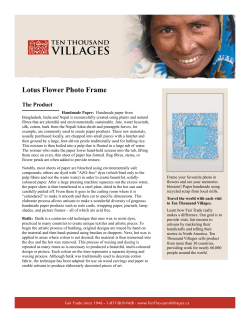
Chronic toxicity of organophosphorous pesticide
Proceedings of 5th International Conference on Environmental Aspects of Bangladesh [ICEAB 2014] Paper E75 Chronic toxicity of organophosphorous pesticide Quinalphos 25EC and its effects on the morphological alterations in the kidney and livers of Silver barb (Barbonymus gonionotus) Golam Mohammod Mostakim1, Mahbuba Monir Mishu1, Md. Khalilur Rahman2 and M. Sadiqul Islam1* 1 Department of Fisheries Biology & Genetics, Bangladesh Agricultural University, Mymensigh-2202, Bangladesh 2Freshwater Station, Bangladesh Fisheries Research Institute (BFRI), Mymensingh-2201, Bangladesh Corresponding e-mail: sadiqul1973@yahoo.com Abstract An experiment was conducted to evaluate the effects of an organophosphorous pesticide, Quinalphos 25EC on different organs of Silver barb, Barbonymus gonionotus. The fishes were exposed to different sub-lethal concentrations of Quinalphos 25EC (0.47 ppm, 10% of LC50 and 0.94 ppm, 20% of LC50 at 96h) for 28 days to assess the effects of histo-architectural changes of kidney and livers of the studied fish. Significant changes in the hepatocytes, mild to severe necrosis, and vacuolation were observed in the liver of treated groups. Highly degenerated kidney tubules and hematopoietic tissues, degeneration of renal corpuscles, vacuolization, and necrosis were evident in the kidney of treated groups. The present investigation sufficiently emphasized that Quinalphos 25EC has adverse effects on the organs of fish. INTRODUCTION Bangladesh has made substantial progress towards achieving its goal of food grain self-sufficiency through the intensification of agriculture. Modern agricultural practices, the introduction of high yield variety seeds, especially the application of pesticides and fertilizers have brought about green revolution and improved world food supply of rice, cereal crops, vegetables and other agricultural plants. The presence of pesticides in fresh water as well as in crop fields is one of the major causes of declining fish production in the natural habitats of Bangladesh. Contaminated water supply by insecticide and chemical is a known cause of fish mortalities. sinusoid dilation were noticed. According to [4] cytoplasmic degeneration, pyknotic nuclei in liver tissues; vacuolation in hepatic cells and rupture of blood vessels; degenerative hepatic cells and necrotic nuclei observed when Heteropneutes fossilis was exposed for 25 days to 5, 10 and 20 ppm Diazinon, respectively. Similar to the present findings were also reported by [2], [5], [6]. The findings clearly indicated that the Quinalphos 25EC is moderately toxic to Silver barb at sub-lethal levels. MATERIALS AND METHODS The study was conducted to accomplish the present investigation for a period of one month from April 2014 to May 2014 in the Wet laboratory of the Department of Fisheries Biology and Genetics, BAU, Mymensingh. Healthy and expected size of the Silver barb (B. gonionotus) were obtained from the local fish farms and reared in the cemented tank. They were housed in large water tank containing tap water provided with aeration system. Fishes were fed twice a day with commercial dry pellets (Krishibid Feed Ltd.) containing 30% protein. An organophosphorus compounds Quinalphos 25EC was collected from a local authorized dealer. The stock solution was prepared according to EC% active ingredient and desired concentrations of pesticides were poured carefully into 25L of de-chlorinated tap water in the test aquaria by a micropipette and gently stirred with a glass rod to ensure complete mixing. Based on the result of the 96h LC50 of Quinalphos 25EC pesticide, 60 fishes of Silver barb were exposed for 28 days to the nominal concentrations of 10% and 20% value of the LC50 (LC50=4.70 ppm) of the Quinalphos 25EC. At least three fishes were sampled from control and the tested groups at 7 and 28 days. Organs like kidney and livers were collected in 10% neutral buffered formalin for histological observations. RESULTS AND DISCUSSION Normal structure of kidney cells were observed in case of controlled fish (Fig. 1). Sub-lethal Quinalphos 25EC exposed kidney sections showed several alterations such as degeneration of renal corpuscles, vacuolization, highly degenerated and distended of kidney tubules and hematopoietic tissue, changes in the nucleus structure, mild to severe necrosis and hemorrhage. Similar to the present findings were reported by [1], [2], [3]. In case of controlled fish, normal structure and systematic arrangement of hepatocytes were observed whereas histo-architectural changes of liver were observed after exposure of Quinalphos 25EC (Fig. 2). The liver of treated fishes showed sign of cellular injury, consisting rupture of endothelial lining in central vein and blood congestion and Fig. 1 Histological changes in kidney (H & E stained, X400) exposed to Quinalphos 25EC (A) Control, (B) and (D) 0.47 ppm at 7 and 28 days, (C) and (E) 0.94 ppm at 7 and 28 days of exposure. Arrowheads are indicating Blood vessel (BV), Hematopoeitic tissue (HT), Kidney tubules (KT), Necrosis (N), Renal corpuscle (RC), Ruptured kidney tubules (RKT), Vacuolation (V) ACKNOWLEDGEMENT This work was supported by a grant IADCAEPP provided by Bangladesh Fisheries Research Institute (BFRI), Mymensingh-2201, Bangladesh. Page | 110 Proceedings of 5th International Conference on Environmental Aspects of Bangladesh [ICEAB 2014] Fig. 2 Histological changes in liver (H & E stained, X400) exposed to Quinalphos 25EC (A) Control, (B) and (D) 0.47 ppm at 7 and 28 days, (C) and (E) 0.94 ppm at 7 and 28 days of exposure. Arrowheads are indicating Hepato-pancreas (HP), Lipid droplet (LD), Necrosis (N), Portal blood vessel (PBV), Vacuolation (V). REFERENCES [1] MZ Rahman, Z Hossain, MFA Mollah, GU Ahmed 2002: Effects of Diazinon 60EC on Anabas testudineus, Channa punctatus, and Barbodes gonionotus. Naga. The ICLARM Quarterly 25 8-11. [2] B Velmurugan, M Selvanayagam, EI Cengiz, E Unlu 2007: The effects of fenvalerate on different tissues of freshwater fish Cirrhinus mrigala. J. Environ. Sci. Health part B 42(2) 157-63. [3] MS Butchiram, KS Tilak, PW Raju 2009: Studies on histopathological changes in the gill, liver and kidney of Channa punctatus (Bloch) exposed to Alachlor. J. Environ. Biol. 30(2) 303-306. [4] SMA Kabir, R Begum 1978: Toxicity of three organo-phosphorus insecticides to singhi fish (Heteropneustes fossolis). Dacca University Studies, Part B. 26: 115-122. [5] AS Bhuiyan, N Badrun, N Quamrun 2001: Effects of Sumithion on the Histological Changes of Spotted Murrel, Channa punctatus (Bloch); Pakistan J. Biol. Sci. 4(10) 1288-1290. [6] Z Hossain, MZ Rahman, MFA Mollah 2002: Effect of Dimecron 100 SCW on Anabas testudineus, Channa punctatus and Barbodes gonionotus. Indian Journal of Fisheries 49(4) 405-417. Page | 111
© Copyright 2025









